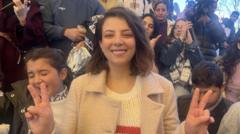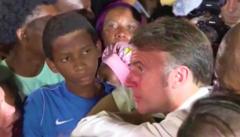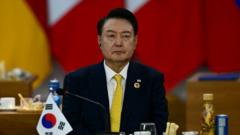The Hakuna Utopia exhibition highlights urban struggles and the potential for resilience through imaginative artwork.
**Imagining Nairobi: Artists Envision a Utopian Future Amid Urban Challenges**

**Imagining Nairobi: Artists Envision a Utopian Future Amid Urban Challenges**
Kenyan artists collaborate to reimagine a better future for Nairobi through art and community engagement.
Nairobi, Kenya’s capital, known as “the green city in the sun,” presents a contrasting picture depending on the viewer's perspective. While those living in comfortable apartments might appreciate the city's green spaces, those in the densely populated slums face daily challenges, including poverty and environmental disasters such as flooding and landslides. Addressing these issues, the art collective Kairos Futura has launched the exhibition titled Hakuna Utopia, showcasing works by seven artists who explore resilience and dystopia in an urban context.
One notable member of the collective, Stoneface Bombaa, hails from Mathare, Nairobi's second-largest informal settlement. After overcoming numerous difficulties, he uses his artwork to draw attention to the struggles experienced by his community, which often lacks adequate jobs, housing, and educational opportunities. Bombaa describes the economic conditions as a “hand-to-mouth economy,” expressing a sense of anger among the residents but believes art can channel that frustration into a positive force. He envisaged creating “micro-utopia” sites across the city, initiating a project he called the “jungle room,” aimed at connecting Mathare’s residents with nature. Unfortunately, plans were thwarted when the intended site was demolished by authorities to construct a new road.
Undeterred by this setback, Bombaa continues his efforts by taking local children from Mathare to explore green spaces within Nairobi to provide them with a taste of nature that is largely absent in their daily lives. He emphasizes the stark contrast between their living situations and the abundant green spaces of the city, declaring that access to nature should be a right for all, not a privilege restricted to those with economic means.
The exhibition also showcases diverse artistic interpretations, such as Coltrane McDowell’s architectural vision inspired by termite mounds, suggesting innovative solutions for future urban infrastructure. Another artist, Abdul Rop, renowned for his woodcut prints, emphasizes collaboration among Nairobians as crucial for achieving a better future. He reflects the frustrations of many young people facing corruption and socio-economic challenges within the political landscape, particularly in light of recent protests organized by Gen Z against unfavorable tax policies.
Rop encourages a creative lens for imagining utopia, believing that through art, young people can visualize an equitable future for Nairobi, stating, “The moment to act for the future is now.” Similarly, Ajax Axe’s contribution transformed mundane school chairs into artistic pieces that foster excitement and comfort, capturing the spirit of innovation within the artistic community.
Through the Hakuna Utopia exhibition, Kairos Futura not only presents thought-provoking artwork but also fosters dialogue surrounding the ecological and societal divides within Nairobi, urging the public to reflect on the potential for a harmonious future built on creativity and unity.
One notable member of the collective, Stoneface Bombaa, hails from Mathare, Nairobi's second-largest informal settlement. After overcoming numerous difficulties, he uses his artwork to draw attention to the struggles experienced by his community, which often lacks adequate jobs, housing, and educational opportunities. Bombaa describes the economic conditions as a “hand-to-mouth economy,” expressing a sense of anger among the residents but believes art can channel that frustration into a positive force. He envisaged creating “micro-utopia” sites across the city, initiating a project he called the “jungle room,” aimed at connecting Mathare’s residents with nature. Unfortunately, plans were thwarted when the intended site was demolished by authorities to construct a new road.
Undeterred by this setback, Bombaa continues his efforts by taking local children from Mathare to explore green spaces within Nairobi to provide them with a taste of nature that is largely absent in their daily lives. He emphasizes the stark contrast between their living situations and the abundant green spaces of the city, declaring that access to nature should be a right for all, not a privilege restricted to those with economic means.
The exhibition also showcases diverse artistic interpretations, such as Coltrane McDowell’s architectural vision inspired by termite mounds, suggesting innovative solutions for future urban infrastructure. Another artist, Abdul Rop, renowned for his woodcut prints, emphasizes collaboration among Nairobians as crucial for achieving a better future. He reflects the frustrations of many young people facing corruption and socio-economic challenges within the political landscape, particularly in light of recent protests organized by Gen Z against unfavorable tax policies.
Rop encourages a creative lens for imagining utopia, believing that through art, young people can visualize an equitable future for Nairobi, stating, “The moment to act for the future is now.” Similarly, Ajax Axe’s contribution transformed mundane school chairs into artistic pieces that foster excitement and comfort, capturing the spirit of innovation within the artistic community.
Through the Hakuna Utopia exhibition, Kairos Futura not only presents thought-provoking artwork but also fosters dialogue surrounding the ecological and societal divides within Nairobi, urging the public to reflect on the potential for a harmonious future built on creativity and unity.





















